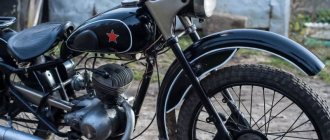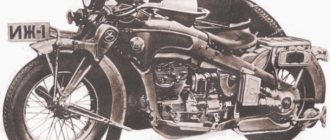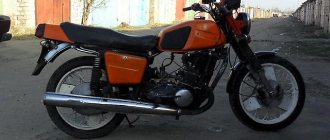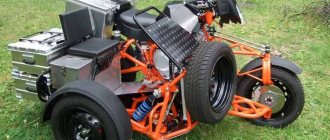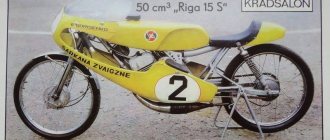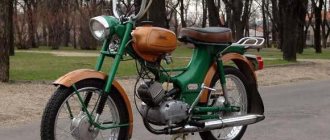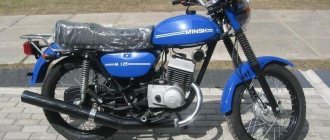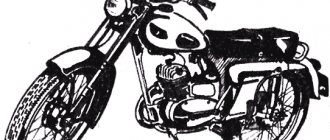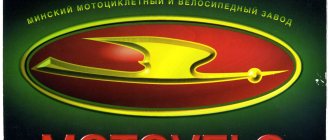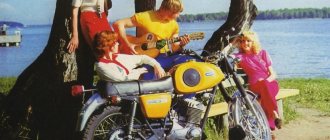The Minsk 125 motorcycle, produced decades ago, was so popular for a reason. It was easier to get than the Voskhod or Ural, and it was cheaper, and thanks to its simple but very durable design, this bike was perfect for a variety of purposes. Some used it as a workhorse in their home village , while other motorcyclists rode it throughout the Soviet Union. Unfortunately, not many copies of the Minsk 125 have survived to this day, and most of them are in a rather poor technical condition. However, if you want, you can find a “live” motorcycle, and it will not cost much.
Technical characteristics Minsk 125
They are completely consistent with their era. Now this bike seems like a relic, but in those days it was very, very good! The Minsk 125 motorcycle weighs only 120 kg , and it has everything necessary for a comfortable ride even with a passenger, and any beginner can handle it. 6.9-horsepower 2-stroke engine Minsk 125 (12 hp, air cooling) . The transmission has 4 gears , which is one more than some other Soviet motorcycles, for example, the Moskva and many Kovrovtsevs.
The frame, of course, is steel . Moreover, the quality of the alloy is surprisingly good, even now many ancient Minsk 125 bikes have not rusted at all, if, of course, they were stored in suitable conditions. The gas tank holds 11 liters of fuel - quite a decent figure, considering the modest gasoline consumption, within 3 liters per 100 km . You just need to remember that pure gasoline cannot be poured into the Minsk 125 motorcycle; it must first be mixed with motor oil .
Drum brakes are responsible for braking, extremely archaic, but surprisingly tenacious if you pay attention to the condition of the brake system and change the pads in time, which, fortunately, can be obtained without any problems even now. And for shock absorption there is a regular telescopic fork and a pair of shock absorbers at the rear. Stiffness used to be often adjusted by installing spacers in the fork or replacing the oil with a harder one, since, according to reviews from Minsk 125 owners, with factory settings the suspensions are excessively soft. However, this feature is characteristic of many motorcycles of the USSR era.
Minsk novelty
Motorcyclists of different generations have long been familiar with light two-wheeled vehicles bearing the image of a stork on the gas tank. Most motorcyclists began their motorcycle biography with them.
Over the years since the start of motorcycle production in Minsk, power has increased significantly, dynamic characteristics have improved, and comfort has increased.
The owner of a two-wheeled car, as a rule, is rarely completely satisfied with it. The more he drives, the more he wants to improve it. Minsk motorcycles are no exception. During the production of the MMVZ-3.115 model (“Behind the Wheel,” 1976, No. 1), the plant received many letters with proposals to change the design. Customer suggestions, as well as test results, influenced the design. And now the improved MMVZ-3.112 motorcycle appeared on sale. Its price is 450 rubles.
At the first glance at the car, the new, more comfortable wide and long saddle catches your eye. It hinges to the right along the way and can be removed from the frame.
The efficiency of the brakes has been significantly increased, especially the front brake, which received quite a lot of complaints. For these purposes, the diameter of the drums was increased (from 125 to 150 mm), new cast aluminum pads and special profile cams were used. Now you can monitor the condition of the brake linings through the hole in the brake disc, closed with a plug. The rear brake support plate transmits reaction force to the frame not through stops, but through a reaction rod attached to the pendulum. The brake pedal is mounted on a separate bracket rather than on the footrest tube.
Other consumer wishes were also taken into account. In particular, the diameter of the wheel hubs, as well as the spokes themselves, has been increased. The spokes became shorter, making the wheel overall stiffer.
The design of the main gear has been changed. The new sealed housing better seals the chain's volume and ensures long-lasting chain operation. The driven sprocket rotates on a separate bearing and is connected to the rear wheel hub not rigidly, through bolts (as was the case on MMVZ-3.115), but through pins with rubber dampers. This design made it possible to significantly reduce shock loads on the engine and chain. At the same time, it became possible to remove the rear wheel from the motorcycle without disassembling the chain cover or removing it.
The pendulum, which on previous models of Minsk motorcycles was mounted on bushings, is now mounted on silent blocks that do not require lubrication. This not only increased the durability of the unit, but also improved the performance of the rear suspension.
In addition to the safety elements that our improved model inherited from its predecessor, MMVZ - 3.115, we have changed the fastening of the passenger footrests, which fold at an angle of 45° when hitting an accidental obstacle. A yoke welded on the left side of the frame instead of mounted on the trunk (as was the case on the previous model) will make it easier to install the motorcycle on the center stand.
The MMVZ-3.112 motorcycle is “armed” with a 12 hp power unit. With. Increase of 1 l. With. achieved not so much by increasing the rotation speed of the crankshaft (6400-6600 versus 6300-6500 rpm for MMVZ-3.115), but by improving gas exchange processes. As a result, not only the power increased, but also the speed characteristics improved. This is facilitated by the new K62K carburetor.
Our latest model is still a child without a name. I would like to find a name for it worthy of a family of motorcycles of the smallest class. Therefore, we invite readers to choose a title. The one recognized as the most successful will decorate the MMVZ motorcycle - 3.112. At the same time, we would like to express our gratitude to our regular correspondents. Levochkin from Orenburg, Fabro from Zaporozhye, Lozhkin from the Perm region and many, many others, whose advice, suggestions and wishes help us improve the design of Minsk motorcycles.
Advantages and disadvantages
Advantages
- Modest mass . The weight of the Minsk 125 motorcycle allows even short and not very physically strong bikers to move the bike with ease.
- Dynamics . Of course, it’s not worth comparing the Minsk 125 with modern motorcycles; after all, they are separated by entire decades. However, it accelerates quite briskly, and the maximum speed in Minsk reaches 95 km/h.
- Simplicity of design . Repairing this bike is not easy, but very simple.
- Availability of spare parts . Even today, there are usually no problems finding them.
Flaws
- 2-stroke engine . When you fill the tank with gasoline at a gas station, you need to add engine oil. In addition, the resource of 2-stroke engines is short.
- Minsk 125 technical characteristics do not really correspond to modern standards. Bikers accustomed to other motorcycles will probably find it boring, unless they are fans of retro technology.
Reviews from owners of Minsk 125
I still remember my Minsk with warmth in my soul, I had my first motorcycle. The year of manufacture is unknown, the condition was ruined, I didn’t drive more than 90, it broke down three times a week, but what impressions!!! Instead of an air filter, there was an oily rag stuck into the carburetor, but it still drove)) I don’t even know how, the rubber was also twenty years old, and nothing)) This is where my love for motorcycles began. Victor, Krasnoznamensk, Minsk 125.
I still own three Minsks, one is in close to collectible condition, the other two act as donors of spare parts. Sometimes I go out for a ride on a “ceremonial” motorcycle in the summer, people break their necks on the street, especially the older generation. Several years of work and under 150 thousand of money were invested into the bike, it looks as if it had just come from the factory. The only non-original parts are Japanese carb and progressive springs in the fork, the rest of the components are original. I’m not going to sell it, it’s a toy for the soul, I also have a BMW RT1150 in the garage for trips. Alexander, Moscow, Minsk 125.
In my time, those who did not have money for the Urals, like me, traveled to Minsk. Of course, it lagged behind the Irbit monster, but its reliability was higher, it broke down much less often, and was easier to repair. It was a really good motorcycle for its time... I gave mine to good hands for restoration ten years ago. Vitaly, Miass, Minsk 125.
Similar models
- Sunrise. Over the years it was produced in 8 different versions, but all of them were equipped with almost identical 175 cc 2-stroke engines.
- Owl . It is a modernized Voskhod 3M.
- Kovrovets . A series of motorcycles produced from the second half of the 40s to the mid-60s.
Total
An entire era has passed with the Minsk 125 motorcycle. Despite the fact that the Belarusian brand was later revived, modern Minskis have nothing in common with their famous ancestor. But in the countries of the former Soviet Union, thousands of old motorcycles produced back in Soviet times are still collecting dust in garages and sheds. And if you suddenly have a desire to join, so to speak, the classics of the motorcycle world, then there is every chance for this, and even a modest budget will not be a hindrance.
Soviet motorcycles for ShKMG, part 24: Minsk MMVZ - 3.216.
The history of racing motorcycles from the Minsk Moto Velo Plant began in 1947, when the plant was still located in Moscow. The first such motorcycle was the M1E, we have already written about it.
M1E on the highway.
The M1E became very popular thanks to the use of the chassis of the M1A road motorcycle. These motorcycles have been used for record breaking, racetrack racing and even enduro and cross-country racing. They were more common on race tracks than, for example, the Kovrovsky K - 125C. But by the mid-fifties, M1E was hopelessly outdated. In 1956, the M1M motorcycle appeared, which had a telescopic suspension in the front and a pendulum in the rear. Athletes abandoned the archaic M1E and competed on Serpukhov motorcycles, equipment of their own design, produced in the countries of the socialist camp, and even on road motorcycles converted for sporting needs. For example, in the 1959 film “Dangerous Corners” you can see a motorcycle with an M1M fork.
No. 6 is most likely an M1M adapted for sports.
This is not to say that the plant was not involved in racing technology. In 1951, the M1Shch modification was created (designed by I. Okunev) with a four-stroke overhead valve engine. The power of such a motor was 12 - 14 hp. In the same year, the M1K modification appeared with a two-stroke liquid-cooled engine with a supercharger, rated at 16.5 hp. But these were prototypes, released in several copies; they did not affect the general situation in motorsports.
In 1961, the ShK-125 motorcycle appeared, and in 1962 M-205, you can also read about them in previous publications. These motorcycles were also produced in three copies each.
In 1970, the prototype M-211, jointly with the Serpukhov Research Institute of Motor Industry, appeared, but it did not become the mass racing motorcycle that Soviet racers needed.
This motorcycle appeared only in 1977. It was MMVZ - 3.216, a motorcycle that opened the way to motorsports for young people throughout the country. It left a significant mark on our racing history, became a staple in its class and remained in production for nine years.
Engineer Alexander Grinkevich, tester Leonid Osipovich, designer Igor Turov.
The design of the motorcycle was aimed at mass production - a motorcycle that was simple and inexpensive to manufacture and maintain. Some parts of the engine (covers, clutch, motor transmission) and chassis (front forks) were used from road bikes, but for the most part the parts were original. The engine received the nickname “hedgehog” due to the characteristic fan-shaped cylinder head. Such engines were also installed on motocross motorcycles MMVZ - 3.221 and karts AKU - 83. Engines for road racing motorcycles differed in gearboxes. If we compare them with the engines of road motorcycles, the differences were in the crankcase with a smaller crank chamber and enlarged bypass channels. The crankshaft featured smaller cheeks and an original connecting rod. While road engines of those years still used bronze bushings in the upper connecting rod head, racing engines already had a needle bearing with a cage. The piston was also original; flat steel rings were installed on it.
Engine MMVZ - 3.216.
The engine is equipped with a rack-and-pinion clutch release and racing ignition; the engine is mounted on rubber silent blocks. Carburetors were used both K-62 and Jikov. The exhaust of early 3.216s consisted of a resonator, on later ones it consisted of a resonator and muffler, made in one piece.
Motorcycle MMVZ - 3.216 without body kit.
The frame is duplex, made according to the traditional design for racing motorcycles of those years. With its low weight, it provides the necessary rigidity of the chassis, the handling of the motorcycle does not cause a feeling of excessive softness or laxity, the motorcycle is clear and predictable in turns, and is stable at high speeds on straight lines.
The wheels with narrow, lightweight rims are shod with L-246 tires, size 2.75X18, created specifically for MMVZ-3.216 in Leningrad. Of course, at that time tires were universal for any weather; slicks were not used in the USSR.
MMVZ - 3.216 on the race track.
Three brake mechanisms were installed on the motorcycle, one at the rear and two at the front. Each mechanism has a two-cam mechanism; the brake shields have air intakes for cooling. It should be noted that the racers did not like these brakes, the cast iron drums created large unsprung masses, the brakes could jam, so they tried to replace them with others, for example, with road motorcycle brakes.
MMVZ - 3.216, front brake from a Minsk road motorcycle.
The rear shock absorber springs are wound with variable pitch and machined externally to ensure the required stiffness. The tank, front wing and tail are made of metal, the fairing is made of fiberglass.
Classic view of MMVZ 3 - 216.
Of course, the riders themselves modified their motorcycles to their own taste; according to the rules of those years, almost nothing except external parts could be changed. But motorsport has always loved a bright, individual appearance.
MMVZ - 3.216 in the so-called “Estonian” body kit - the characteristic fairing and tail are visible. Such parts were produced by the production enterprise of the Central Committee of DOSAAF USSR “Vihur” in the city of Tallinn.
Modern photo of MMVZ - 3.216 in Estonian processing.
Motorcycles Minsk MMVZ 3.216 received the nickname “mosquito” due to the characteristic high-pitched sound of the engine operating at high speeds. Both adults and children performed there. Under racing conditions, MMVZ-3.216 has proven its reliability and maintainability.
The youth of the 80s and their racing motorcycles - two 3.216 and one Voskhod ShK4.
Minsk MMVZ - 3.216 was produced from 1977 to 1986, after which it was replaced by MMVZ - 3.227.
Thanks to the mass production of MMVZ-3.216, relatively many of these motorcycles have survived to this day. They are sometimes found on sale, they are in private collections and museums. Some of them are still used in amateur racing.
Radically modified 3.216 from Sweden.
Arnis Tomass from Latvia and his MMVZ - 3.216.
3,216 from Estonia.
Beautifully restored with great attention to all the smallest details MMVZ - 3.216 Tony Laan from Estonia. You can see it in detail in the video -
Often motorcycles are found in this condition. Either way, it's a huge asset to our racing history.
MMVZ - 3.216 Kaspars Brigzne from Latvia. This is not dirt, this is the dust of centuries.
MMVZ - 3.216 in excellent authentic condition from our friend Vyacheslav from Moscow. Currently located in Ivanovo.
MMVZ - 3.216 from the Sverdlovsk region.
Motorcycle from the collection of the UMMC Museum from Verkhnyaya Pyshma.
Perhaps this is where we can finish the story about this motorcycle. I am sure that many of our compatriots who still remember the 70s and 80s of the last century remember this “mosquito” with warmth, remember how he shone at the races during their youth.
For the most curious - video review:
Video Review
Specifications
| Maximum engine power: | 12 HP |
| Working volume: | 125 cm3 |
| Motor type (cylinder arrangement, number of strokes): | 1 cylinder, 2 strokes |
| Number of cylinders: | 1 |
| Number of valves: | |
| Intake type (Injector / Carburetor): | |
| Bore and stroke: | |
| Starting system (Electric starter, kick starter): | |
| Maximum speed in km/h: | 95 km/h |
| Cooling system: | Air cooling |
| Transmission (gearbox): | 4-speed, manual |
| Clutch (Dry / Wet): | |
| Drive unit: | Chain |
| Frame: | Steel |
| Chassis | |
| Suspension (front/rear travel): | |
| Brakes (Front/Rear): | |
| Wheels / Tires / Rubber: | |
| Dimensions and weight | |
| Dimensions (Length / Width): | |
| Seat height: | |
| Ground clearance: | |
| Curb weight: | |
| Wheelbase: | 1230 mm |
| Weight: | 120 kg |
| Fuel tank capacity: | 11 l. |
| Battery capacity: | |
| Year of release: | |
| Country of Origin: |
Buy in the online store, best prices, inexpensive delivery
Quite a few motorcycles have been tested by the editorial office in recent years: various models of YAVA, IZHE, ChZ, Dnepr12. As a rule, these were powerful and high-speed cars, designed for a fairly demanding consumer. Well, what is a light motorcycle today? To answer this question, we turned to the Minsk Motorcycle Plant, which provided a production motorcycle of the latest model MMVZ 3.112 for testing.
It was not by chance that we became interested in this class. Every year, about 200 thousand 125 cc cars roll off the assembly line, which makes up a significant share of the total production of motorcycles in the country. They are popular among those who need an economical and fairly fast vehicle. Low price and ease of control are the qualities that make these motorcycles especially attractive for beginners. By the way, the author’s acquaintance with motorcycle technology also began with a similar machine.
And so it seemed to happen all over again. The appearance of the car, as they say, is attractive. There is nothing too flashy or ultra-modern about it. By today's standards, it is rather conservative. However, all the large elements that determine the appearance of the motorcycle, the tank, the saddle, the side boxes, the wheel guards, are proportional, designed in the same style and create a calm, harmonious whole. True, upon closer inspection the eye encounters details that have hardly changed since the 60s, or even the 50s. Thus, the headlight differs from the one produced thirty years ago only in the absence of a speedometer and ignition switch. However, the latter, although now enclosed in a separate building, has also not become more modern. And the dimensions of this case make me sad about the absence of a tachometer, for which it was clearly intended.
Motorcycle manufacturers have long blamed, and apparently rightly so, specialized related factories for the obsolescence and low quality of motorcycle instruments. Perhaps the Minsk residents will forward to them our other reproach regarding the unsuccessful design of locks for glove boxes (they say, the suppliers did not have suitable ones). Be that as it may, locks in the form of long bolts with special heads are inconvenient: to unlock or lock the drawer, you have to tinker quite a bit.
These are external impressions. And on the eve of departure, a surprise awaited us: the trunk did not want to go into place. Its mounting brackets turned out to be 12 millimeters shorter than necessary. This is probably due to chance, but will such an explanation help a buyer who is faced with a similar surprise?
The first trips brought more pleasant impressions. The engine invariably started easily, worked without interruptions or failures, and smoked even less than one might expect during break-in. The engine's voice is moderately loud, the level of vibrations it creates is very low, which makes it suitable for fairly long trips. The engine quickly picks up speed, providing the motorcycle with good dynamics. Thanks to this, you don’t feel like a nuisance at the busiest intersection. Except for the frequent, alas, cases when second gear treacherously does not engage after first. The hope that this defect will disappear with running-in has not yet been realized.
The first impression of the 12-horsepower MMVZ3.112 engine is quite favorable.
This bolt serves as a tool box lock.
This combination of instruments cannot be called successful.
It is still too early to fully evaluate the quality of the engine and transmission: after all, the motorcycle was just being run-in, the mode of which we tried to make as gentle as possible: country trips on smooth asphalt highways predominated. Nevertheless, we managed to feel the narrowness of the engine’s operating range: when the speed is not too high, any additional resistance to movement (lifting, strong wind) manifests itself in a rapid drop in revolutions, followed by a transition to a lower gear. Well, here the forced engine of the Minsk car naturally repeats behavior of many high-speed brethren. Whether it is necessary to complain about this will be shown more clearly by further tests.
But we managed to complain about the design of the front fork, and more than once. Its ability to dampen shocks from the road (so far only asphalted!) is unsatisfactory. In addition, after the first thousand kilometers, one of the feathers began to leak. Unfortunately, she was not the only one: the screw in the bottom of the box housing did not find its place, and oil was constantly thrown out of it along the thread of the hole.
For drivers of average height, which includes the author (175 cm), the seat on the motorcycle is comfortable, so riding it does not tire. The width and height of the steering wheel, the location of the footrests, the size and rigidity of the seat were successfully found. The clutch and front brake control levers are not so convenient; The driver's fingers grasp only their ends, overcoming increased force because of this. The turn signal switch and light switch are inconvenient to use and, in addition, do not have a clear fixation in a certain position. The design of the gas handle was not well thought out: the screws for securing it had to be tightened every now and then.
These little things are especially annoying against the backdrop of successful, correct decisions. These include, in our opinion, the use of a battery-free electrical circuit, an electronic ignition system, and a sealed rear circuit casing. Among other advantages, all this allows you to minimize motorcycle maintenance.
So, let's summarize the first results. The Minsk car has an attractive appearance, comfortable, fatigue-free seating, low maintenance, a lively, fairly torquey engine, and effective brakes. We hope that continued testing will help complete this list. Passivity, in addition to some instruments and the front fork, is determined mainly by the quality of the motorcycle. It depends on him whether the balance of our impressions and, most importantly, the balance of the buyer’s impressions will be positive.
: just sabur
Motorcycle M1A "Moscow" - Ancestor of the "Leader"
| Length, mm | |
| Width, mm | |
| Height, mm | |
| Base, mm | |
| Ground clearance, mm | |
| Maximum load, kg | |
| Dry weight, kg | |
| Max. speed, km/h | |
| Average fuel consumption, l/100 km | |
| Cylinder diameter, mm | |
| Piston stroke, mm | |
| Engine displacement, cm3 | |
| Compression ratio | |
| Engine power, hp | |
| Speed at max. power rpm | |
| Carburetor | |
| Air filter | reticulate |
| Fuel | gasoline A66 |
| Gas tank capacity, l | |
| Motor transmission | Chain PV-9, 525-1000 |
| Gear ratio | |
| Clutch | cork, in oil bath |
| Number of master disks | |
| Transmission | 3-speed |
| Gear ratios I II III IV | 3.16 1.62 1.00 absent |
| main gear | open circuit PR-12.7-1800-2 |
| Gear ratio | |
| tubular, closed type | |
| Front fork | |
| Rear suspension | absent. |
| Wheels (hubs) | stamped |
| 65-484(2.50-19″) | |
| spring | |
| Generator | |
| Battery | |
| Ignition coil | |
| Ignition timing (mm to TDC) | |
| Headlight bulb | |
| Stop signal | absent |
| Direction indicator | absent |
| Speedometer | |
| Signal | |
| Light switch | |
| Electronic switch | absent |
| Throttle | absent |
| Turn signal relay | missing |
ROAD MOTORCYCLE M1M
At the end of 1956, the plant switched to production of the modernized M1M motorcycle. It already has a pendulum rear wheel suspension with spring shock absorbers. The suspension was equipped with dampers in which vibrations were damped by dry friction between friction washers. Instead of a telescopic one, a push-type short-link front fork with spring shock absorbers was used.
The M1M was the first to use electrical equipment that operated on alternating current. The engine has also changed. Instead of cast ones, drilled cylinder purge channels with aluminum plugs were used. A new K-55 carburetor with a diffuser diameter of 20 mm was installed, as well as a new cylinder head with a slightly increased compression ratio. This made it possible to increase engine power to 5 hp. s., and the maximum speed is up to 75 km/h. The M1M motorcycle was distinguished by the original shape of deep welded wings and a very soft suspension, which, however, somewhat worsened stability on bad roads.
| Length, mm | |
| Width, mm | |
| Height, mm | |
| Base, mm | |
| Ground clearance, mm | |
| Maximum load, kg | |
| Dry weight, kg | |
| Max. speed, km/h | |
| Average fuel consumption, l/100 km | |
| Cylinder diameter, mm | |
| Piston stroke, mm | |
| Engine displacement, cm3 | |
| Compression ratio | |
| Engine power, hp | |
| Speed at max. power rpm | |
| Carburetor | |
| Air filter | reticulate |
| Fuel | gasoline A66 |
| Gas tank capacity, l | |
| Motor transmission | Chain PV-9, 525-1000 |
| Gear ratio | |
| Clutch | cork, in oil bath |
| Number of master disks | |
| Transmission | 3-speed |
| Gear ratios I II III IV | 3.16 1.62 1.00 absent |
| main gear | open circuit PR-12.7-1800-2 |
| Gear ratio | |
| tubular, closed type | |
| Front fork | |
| Rear suspension | |
| Wheels (hubs) | stamped |
| 65-484(2.50-19″) | |
| spring | |
| Generator | |
| Battery | absent |
| Ignition coil | KM-01 or B-50 |
| Ignition timing (mm to TDC) | |
| Headlight bulb | |
| Stop signal | absent |
| Direction indicator | absent |
| Speedometer | |
| Signal | |
| Light switch | |
| Electronic switch | absent |
| Throttle | absent |
| Turn signal relay | missing |
ROAD MOTORCYCLE M-103
1961 _ in the history of M.M.V.Z. was marked by the release of a new motorcycle model, the M1M was replaced by the M-103, in which the plant abandoned the wheel suspension with friction shock absorbers and a short-link pendulum front fork, and made the wheel suspension with a traditional telescopic front fork but with hydraulic shock absorbers, which have gained a good reputation among motorcyclists, The rear wheel suspension was also equipped with hydraulic shock absorbers. In addition, this new model M-103 began to be equipped with a contact-oil instead of a mesh air filter - which significantly improved air purification (which could be expected from a tiny by today's standards and very ineffective mesh filter; it is not surprising that the piston rings in those days sometimes had to be changed after 4 thousand km.) due to which the engine life and service life of the piston increased, so this was an important improvement, considering that the car was intended for a rural consumer. The hood of the motorcycle has also changed - the wings have once again become profiled and less voluminous.
| Length, mm | |
| Width, mm | |
| Height, mm | |
| Base, mm | |
| Ground clearance, mm | |
| Maximum load, kg | |
| Dry weight, kg | |
| Max. speed, km/h | |
| Average fuel consumption, l/100 km | |
| Cylinder diameter, mm | |
| Piston stroke, mm | |
| Engine displacement, cm3 | |
| Compression ratio | |
| Engine power, hp | |
| Speed at max. power rpm | |
| Carburetor | |
| Air filter | contact-oil |
| Fuel | gasoline A66 |
| Gas tank capacity, l | |
| Motor transmission | Chain PV-9, 525-1000 |
| Gear ratio | |
| Clutch | cork, in oil bath |
| Number of master disks | |
| Transmission | 3-speed |
| Gear ratios I II III IV | 3.24 1.60 1.00 absent |
| main gear | open circuit PR-12.7-1800-2 |
| Gear ratio | |
| tubular, closed type | |
| Front fork | telescope. with hydraulic shock. |
| Rear suspension | lever with hydraulic shock. |
| Wheels (hubs) | stamped |
| 65-484(2.50-19″) | |
| spring | |
| Generator | |
| Battery | absent |
| Ignition coil | KM-01 or B-50 |
| Ignition timing (mm to TDC) | |
| Headlight bulb | |
| Stop signal | absent |
| Direction indicator | absent |
| Speedometer | |
| Signal | |
| Light switch | |
| Electronic switch | absent |
| Throttle | absent |
| Turn signal relay | missing |
ROAD MOTORCYCLE M-104
In August 1964, the plant began production of a new model of the M-104 motorcycle, which differed from the previous model not only in appearance and finishing elements, such as: a double cushion-type saddle, and facing panels near the carburetor and the seat frame, but robots were also carried out to improve the performance of the engine, which received a new modernized K-55 carburetor and the compression ratio was increased from 7.6 to 8.0 and the exhaust system was also changed, a new muffler was installed, resulting in a power of 5.5 liters .s., and the motorcycle began to reach speeds of up to 75 km/h, but at the same time the weight of the car (dry) increased - 90 kg.
| Length, mm | |
| Width, mm | |
| Height, mm | |
| Base, mm | |
| Ground clearance, mm | |
| Maximum load, kg | |
| Dry weight, kg | |
| Max. speed, km/h | |
| Average fuel consumption, l/100 km | |
| Cylinder diameter, mm | |
| Piston stroke, mm | |
| Engine displacement, cm3 | |
| Compression ratio | |
| Engine power, hp | |
| Speed at max. power rpm | |
| Carburetor | |
| Air filter | contact-oil |
| Fuel | gasoline A66 |
| Gas tank capacity, l | |
| Motor transmission | Chain PV-9,525-1000 |
| Gear ratio | |
| Clutch | cork, in oil bath |
| Number of master disks | |
| Transmission | 3-speed |
| Gear ratios I II III IV | 3.24 1.60 1.00 absent |
| main gear | open circuit PR-12.7-1800-2 |
| Gear ratio | |
| tubular, closed type | |
| Front fork | telescope. with hydraulic shock absorber. |
| Rear suspension | lever with hydraulic shock absorber. |
| Wheels (hubs) | stamped |
| 65-484(2.50-19″) | |
| double, pillow type | |
| Generator | |
| Battery | absent |
| Ignition coil | KM-01 or B-50 |
| Ignition timing (mm to TDC) | |
| Headlight bulb | |
| Stop signal | absent |
| Direction indicator | absent |
| Speedometer | |
| Signal | |
| Light switch | |
| Electronic switch | absent |
| Throttle | absent |
| Turn signal relay | missing |
ROAD MOTORCYCLE M-105
In 1966 K.B. and engineer M.M.V.Z. They are doing a lot of work to increase the power and reliability of the engine and the motorcycle as a whole, as a result of which the frame was somewhat strengthened, a connecting rod lower head bearing with a separator was used instead of a bronze bushing, the introduction of main drive chain protection with stamped casings and rubber chain covers increased the service life and reliability Last, a new throttle grip was introduced. The cylinder-piston group was replaced and modernized; for the first time, the plant used, instead of a solid cast iron cylinder, a cast iron liner cast into an aluminum cylinder jacket, which improved its heat transfer and facilitated the temperature regime of the engine as a whole, and as a result of the use of a new K-36M carburetor and muffler, it was possible to increase power to 7 l. With. at 5500 rpm. crankshaft, and the maximum speed is up to 80 km/h.
But the most important innovation is a four-speed gearbox , because the constant increase in engine power narrowed its operating range and three gears were no longer enough. For the first time, a brake light was installed on the new one, as well as a speedometer illumination lamp; the remaining components of the chassis and hood have undergone virtually no changes. First, the first prototypes and technological tests, after which at the end of 1967 the plant began producing a new model of the M-105 motorcycle. A new engine was installed on it, which became the base for subsequent models of Minsk motorcycles.
| Length, mm | |
| Width, mm | |
| Height, mm | |
| Base, mm | |
| Ground clearance, mm | |
| Maximum load, kg | |
| Dry weight, kg | |
| Max. speed, km/h | |
| Average fuel consumption, l/100 km | |
| Cylinder diameter, mm | |
| Piston stroke, mm | |
| Engine displacement, cm3 | |
| Compression ratio | |
| Engine power, hp | |
| Speed at max. power rpm | |
| Carburetor | |
| Air filter | contact-oil |
| Fuel | gasoline A76 |
| Gas tank capacity, l | |
| Motor transmission | Chain PV-9,525-1000 |
| Gear ratio | |
| Clutch | cork, in oil bath |
| Number of master disks | |
| Transmission | 4-speed |
| Gear ratios I II III IV | 3,18 1,97 1,39 1,00 |
| main gear | closed circuit PR-12.7-1800-2 |
| Gear ratio | |
| tubular, closed type | |
| Front fork | telescope. with hydraulic shock absorber. |
| Rear suspension | lever with hydraulic shock absorber. |
| Wheels (hubs) | stamped |
| 65-484(2.50-19″) | |
| double, pillow type | |
| Generator | |
| Battery | absent |
| Ignition coil | |
| Ignition timing (mm to TDC) | |
| Headlight bulb | |
| Stop signal | |
| Direction indicator | absent |
| Speedometer | |
| Signal | |
| Light switch | |
| Electronic switch | absent |
| Throttle | absent |
| Turn signal relay | missing |
ROAD MOTORCYCLE M-106
“Minsk” M106 is a light road double motorcycle from the “Minsk” motorcycle family produced by the Minsk Motorcycle and Bicycle Plant (MMVZ, Republic of Belarus, Minsk, modern name - Motovelo OJSC). It was produced from 1971 to 1973. The predecessor of the motorcycle was the Minsk M105 model, the successor was the Minsk MMVZ-3.111. At the end of 1971, as a result of modernization, production of the modernized M-106 , the engine power of which, due to better cylinder filling, the use of a new muffler and K-36S carburetor with a diffuser diameter of 24 mm, was raised to 9 liters. with .. As a result of increasing power and increasing the maximum speed to 85 km/h, the plant strengthens the frame and replaces the wheel hub bearings from No. 201 to No. 202. The changes also affect the appearance of the gas tank - it has acquired a more modern shape and can hold 12 liters fuel.
Device
The M106 motorcycle model is a further development of the previous M105 model. The changes also concern the appearance - the gas tank has acquired a more modern shape and can hold 12 liters of fuel. For the first time, the M-106 motorcycle was equipped with a trunk, which became a mandatory accessory for Minsk motorcycles.
Engine
The engine is single-cylinder, air-cooled and dual-channel return blown. Aluminum alloy cylinder head with decompressor. The engine on the M106 model was modified: engine power was increased due to better cylinder filling, the use of a new muffler and a K-36S carburetor with a diffuser diameter of 24 mm, resulting in a power of 9 hp. With. at 5500 rpm. The engine requires fuel from a mixture of oil and gasoline in a ratio of 1:25.
Transmission
The gearbox is four-speed. The gear shift mechanism is foot-operated. Multi-disc clutch in oil bath. The drive to the rear wheel is by chain, with the main drive protected by stamped casings and rubber chain covers.
Chassis
The frame is tubular, closed, reinforced (in relation to M105). The wheel hub bearings have been increased from No. 201 to No. 202. The front fork is of a telescopic type with hydraulic shock absorbers. The rear suspension is pendulum type with hydraulic shock absorbers.
| Length, mm | |
| Width, mm | |
| Height, mm | |
| Base, mm | |
| Ground clearance, mm | |
| Maximum load, kg | |
| Dry weight, kg | |
| Max. speed, km/h | |
| Average fuel consumption, l/100 km | |
| Cylinder diameter, mm | |
| Piston stroke, mm | |
| Engine displacement, cm3 | |
| Compression ratio | |
| Engine power, hp | |
| Speed at max. power rpm | |
| Carburetor | |
| Air filter | contact-oil |
| Fuel | gasoline A76 |
| Gas tank capacity, l | |
| Motor transmission | Chain PV-9,525-1000 |
| Gear ratio | |
| Clutch | cork, in oil bath |
| Number of master disks | |
| Transmission | 4-speed |
| Gear ratios I II III IV | 2,92 1,97 1,33 1,00 |
| main gear | closed circuit PR-12.7-1800-2 |
| Gear ratio | |
| tubular, closed type | |
| Front fork | telescope. with hydraulic shock absorber. |
| Rear suspension | lever with hydraulic shock absorber. |
| Wheels (hubs) | stamped |
| 65-484(2.50-19″) | |
| double, pillow type | |
| Generator | |
| Battery | absent |
| Ignition coil | |
| Ignition timing (mm to TDC) | |
| Headlight bulb | |
| Stop signal | |
| Direction indicator | absent |
| Speedometer | |
| Signal | |
| Light switch | |
| Electronic switch | absent |
| Throttle | absent |
| Turn signal relay | missing |
ROAD MOTORCYCLE MMVZ-3.111
In 1973, the Minsk Motorcycle Plant began producing a new model of the MMVZ-3.111 motorcycle, which is radically different from its predecessors, firstly, remaining true to its traditions of modernizing the engine power plant, the engine power was increased to 9.5 hp, which allowed In turn, the maximum speed was increased to 90 km/h, new 18″ (3.00 – 18″) tires with aluminum hubs were also installed, and instead of a contact-oil air filter, a paper air filter was used, and a central light switch was used in the lighting system. The 3.111 motorcycle was equipped with direction indicators for the first time, which made riding on public roads safer. The appearance of the motorcycle also becomes more modern, which was facilitated by the elimination of cladding, as well as the original shape of the new gas tank, tool boxes and engine crankcase covers. Simultaneously with the release of the new model, the plant switches to the International System of Designations and Markings of Motor Vehicles: The new accepted marking of the motorcycle began to designate: MMVZ - manufacturer; 3 – motorcycle class (up to 125 cm³); 1 – type of motorcycle (road); 11 – serial model number.
In MMVZ-3. 111 83.7% of units and parts are interchangeable. Thus, the engine, front fork, rear wheel suspension shock absorbers, saddle and some other components can be used on previous models without changes. What are its differences? First of all, an unusual brand. It now corresponds to the classification and means: Minsk Motorcycle and Bicycle Plant, number 3 - motorcycle class (125 cm3), the first unit - type - road, 11 - serial number of the model produced by the plant. Modern appearance, a combination of black and cherry color are the distinctive features of the motorcycle. A comfortable saddle, a new form of tool boxes (two), harmonizing in shape with the new gas tank, cylinder and engine crankcase, give the motorcycle a sporty look. The engine is equipped with a new cylinder and crankcase covers. It became more powerful by 0.5 liters. With. The maximum speed has also increased by 5 km/h. The carburetor and air filter are made open, which provides easy access to them. The frame has been modified. The most loaded frame pipes have increased wall thickness. The design of the front fork suspension has been improved. Instead of stamped steel hubs, cast aluminum alloy hubs are installed. As a result, the wheels became stiffer and stronger. The electrical equipment has been replenished with direction indicators, a breaker relay, a switch and a throttle, which prevents the taillight and speedometer lamps from burning out. Good illumination of the road is provided by a new headlight with a built-in speedometer. Tests have shown that the new motorcycle is more reliable and durable compared to the M-106. Like previous models of Minsk motorcycles, MMVZ-3.111 is suitable for use on bad roads and in off-road conditions.
| Length, mm | |
| Width, mm | |
| Height, mm | |
| Base, mm | |
| Ground clearance, mm | |
| Maximum load, kg | |
| Dry weight, kg | |
| Max. speed, km/h | |
| Average fuel consumption, l/100 km | |
| Cylinder diameter, mm | |
| Piston stroke, mm | |
| Engine displacement, cm3 | |
| Compression ratio | |
| Engine power, hp | |
| Speed at max. power rpm | |
| Carburetor | |
| Air filter | paper |
| Fuel | gasoline A76 |
| Gas tank capacity, l | |
| Motor transmission | Chain PV-9, 525-1200 |
| Gear ratio | |
| Clutch | cork, in oil bath |
| Number of master disks | |
| Transmission | 4-speed |
| Gear ratios I II III IV | 3,18 1,97 1,39 1,00 |
| main gear | closed circuit PR-12.7-1800-2 |
| Gear ratio | |
| tubular, closed type | |
| Front fork | telescope. with hydraulic shock. |
| Rear suspension | lever with hydraulic shock. |
| Wheels (hubs) | |
| 80-459(3.00-18″) | |
| double, pillow type | |
| Generator | |
| Battery | absent |
| Ignition coil | |
| Ignition timing (mm to TDC) | |
| Headlight bulb | |
| Stop signal | |
| Direction indicator | |
| Speedometer | |
| Signal | |
| Light switch | |
| Electronic switch | |
| Throttle | |
| Turn signal relay |
ROAD MOTORCYCLE MMVZ-3.115
Since 1976 The plant begins production of a new model of the MMVZ-3.115 motorcycle. It differs from its predecessor with a new muffler, a redesigned headlight, and a modified installation of the center switch and speedometer.
On older motorcycle models, the center switch was inside the headlight, as was the speedometer. On MMVZ-3.115, the switch and speedometer were moved out of the headlight into a separate block.
In addition, the muffler was changed in the motorcycle, and a different K62S carburetor was introduced, which at that time was highly technical and advanced. On previous models, as you remember, the K36 series was installed. The compression ratio was increased to 10.5 units, which means by as much as two units. This increased the maximum power to 11 hp. With. If the 3.111 model had only 9.5 horses, then it is clear that the motorcyclists of that time felt the changes.
Engine power has increased and the maximum speed has increased to 95 km/h. It is also worth adding that the changes in power also entailed a change in the main gear. On MMVZ 3.115 the gear ratio became 2.73.
The gas tank capacity has also increased by half a liter, but the external appearance of the tank remains the same.
Although the on-board voltage remained 6 V, the ignition was already electronic. The generator was changed to the G-427 model; it had high-voltage windings for ignition and greater power for lighting. The high-voltage transformer for electronic ignition was installed in the B-300B series. The lighting night was also different.
And the last, important change that must be announced is the gasoline that was preferred for the engine; it became the A-76 series. Previously, according to the instructions, it was necessary to fill in lower octane A-72.
The MMVZ 3.115 motorcycle was at one time the most advanced model. And so on until 1981, when an even newer model 3.112 came out, and it had finally turned the old Minsk motorcycle into a modern and convenient new type of motorcycle.
| Length, mm | |
| Width, mm | |
| Height, mm | |
| Base, mm | |
| Ground clearance, mm | |
| Maximum load, kg | |
| Dry weight, kg | |
| Max. speed, km/h | |
| Average fuel consumption, l/100 km | |
| Cylinder diameter, mm | |
| Piston stroke, mm | |
| Engine displacement, cm3 | |
| Compression ratio | |
| Engine power, hp | |
| Speed at max. power rpm | |
| Carburetor | |
| Air filter | paper |
| Fuel | gasoline A76 |
| Gas tank capacity, l | |
| Motor transmission | Chain PV-9, 525-1200 |
| Gear ratio | |
| Clutch | cork, in oil bath |
| Number of master disks | |
| Transmission | 4-speed |
| Gear ratios I II III IV | 2,92 1,97 1,33 1,00 |
| main gear | closed circuit PR-12.7-1800-2 |
| Gear ratio | |
| tubular, closed type | |
| Front fork | telescope. with hydraulic shock. |
| Rear suspension | lever with hydraulic shock. |
| Wheels (hubs) | |
| 80-459(3.00-18″) | |
| double, pillow type | |
| Generator | G-421 (G-427) |
| Battery | absent |
| Ignition coil | B-300 (B-300B) |
| Ignition timing (mm to TDC) | |
| Headlight bulb | |
| Stop signal | |
| Direction indicator | |
| Speedometer | |
| Signal | |
| Light switch | |
| Electronic switch | — (KET-1) |
| Throttle | |
| Turn signal relay |
MOTORCYCLE MMVZ-3.112-3.112.1
In June 1980, the plant began producing the longest-producing model, “M.M.V.Z.-3.112.” The plant has been producing it with some alterations and modernizations for more than 20 years, I won’t argue, there are different things, there are ups and downs, and so, when on one of the modifications of this motorcycle, namely on the “3.112.1” machine of 1984, a power of 12 hp was achieved. at 6950 rpm, and the maximum torque is 1.2 kgf.m. came at 6800 rpm, it was necessary to hit the all-clear in 1987 . a new variety (modification) appears - “ MMVZ-3.112.11 ” with ... a derated engine so that this machine can be used not only on highways
Minsk MMVZ 3.112 Minsk new
Motorcyclists of different generations have long been familiar with light two-wheeled vehicles bearing the image of a stork on the gas tank. Most motorcyclists began their motorcycle biography with them. Over the years since the start of motorcycle production in Minsk, power has increased significantly, dynamic characteristics have improved, and comfort has increased. The owner of a two-wheeled car, as a rule, is rarely completely satisfied with it. The more he drives, the more he wants to improve it. Minsk motorcycles are no exception. During the production of the MMVZ-3.115 model (“Behind the Wheel,” 1976, No. 1), the plant received many letters with proposals to change the design. Customer suggestions, as well as test results, influenced the design. And now the improved MMVZ-3.112 motorcycle appeared on sale. Its price is 450 rubles. At the first glance at the car, the new, more comfortable wide and long saddle catches your eye. It hinges to the right along the way and can be removed from the frame. The efficiency of the brakes has been significantly increased, especially the front brake, which received quite a lot of complaints. For these purposes, the diameter of the drums was increased (from 125 to 150 mm), new cast aluminum pads and special profile cams were used. Now you can monitor the condition of the brake linings through the hole in the brake disc, closed with a plug. The rear brake support plate transmits reaction force to the frame not through stops, but through a reaction rod attached to the pendulum. The brake pedal is mounted on a separate bracket rather than on the footrest tube. Other consumer wishes were also taken into account. In particular, the diameter of the wheel hubs, as well as the spokes themselves, has been increased. The spokes became shorter, making the wheel overall stiffer. The design of the main gear has been changed. The new sealed housing better seals the chain's volume and ensures long-lasting chain operation. The driven sprocket rotates on a separate bearing and is connected to the rear wheel hub not rigidly, through bolts (as was the case on MMVZ-3.115), but through pins with rubber dampers. This design made it possible to significantly reduce shock loads on the engine and chain. At the same time, it became possible to remove the rear wheel from the motorcycle without disassembling the chain cover or removing it. The pendulum, which on previous models of Minsk motorcycles was mounted on bushings, is now mounted on silent blocks that do not require lubrication. This not only increased the durability of the unit, but also improved the performance of the rear suspension. In addition to the safety elements that our improved model inherited from its predecessor, MMVZ - 3.115, we have changed the fastening of the passenger footrests, which fold at an angle of 45° when hitting an accidental obstacle. A yoke welded on the left side of the frame instead of mounted on the trunk (as was the case on the previous model) will make it easier to install the motorcycle on the center stand. The MMVZ-3.112 motorcycle is “armed” with a 12 hp power unit. With. Increase of 1 l. With. achieved not so much by increasing the rotation speed of the crankshaft (6400-6600 versus 6300-6500 rpm for MMVZ-3.115), but by improving gas exchange processes. As a result, not only the power increased, but also the speed characteristics improved. This is facilitated by the new K62K carburetor. Our latest model is still a child without a name. I would like to find a name for it worthy of a family of motorcycles of the smallest class. Therefore, we invite readers to choose a title. The one recognized as the most successful will decorate the MMVZ motorcycle - 3.112. At the same time, we would like to express our gratitude to our regular correspondents. Levochkin from Orenburg, Fabro from Zaporozhye, Lozhkin from the Perm region and many, many others, whose advice, suggestions and wishes help us improve the design of Minsk motorcycles. Technical characteristics of the motorcycle Minsk 112 General data. Weight (dry) - 104.5 kg. Maximum load - 150 kg. Maximum speed is 95 km/h. Fuel consumption: control at a speed of 71 km/h - 3.3 l/100 km, average operating - 4.0-4.5 l/100 km. Dimensions Length - 2100 mm. Width - 790 mm. Height - 1200 mm. Vase - 1230-1320 mm. Ground clearance - 125 mm (not less). Engine. Single cylinder, two stroke. Working volume - 123 cm3. Compression ratio - 9.2-9.8. The gasoline used is A-76. Power - 12 l. With. at 6400-6600 rpm. Transmission. The clutch is multi-plate in an oil bath. The gearbox is four-speed with foot shift. The main gear is a chain in a sealed casing. Tires - 3.00-18. Crew part. The frame is single tubular. Brakes - drum. Suspension: front wheel - spring telescopic fork with hydraulic shock absorbers, rear wheel - pendulum spring fork with hydraulic shock absorbers. The MMVZ-3.112 motorcycle will be delivered to consumers painted red with some black parts, as in the picture. A certain number of cars will be blue and black. The improved model can also be easily distinguished by its enlarged brake drums and reshaped saddle.
